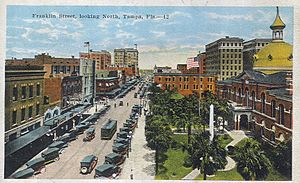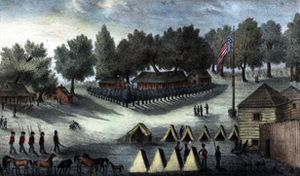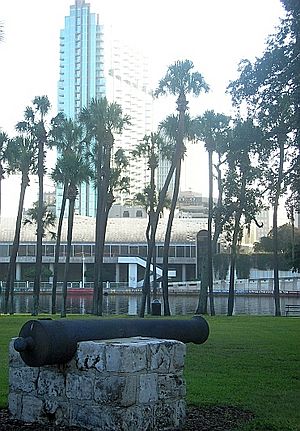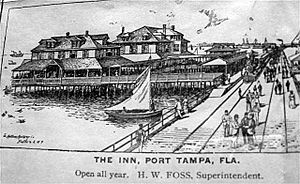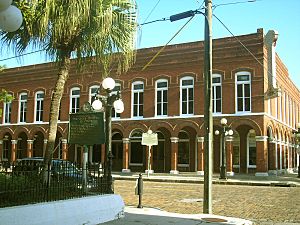History of Tampa, Florida facts for kids
Tampa is a city in Hillsborough County, Florida, on the west coast of the United States.
People have lived in the Tampa Bay area for thousands of years. The Manasota culture was the first known group, from about 500 BCE to 700 CE. They later became the Safety Harbor culture. The Tocobaga and Pohoy tribes were part of this culture. They lived along the northern shore of Tampa Bay when Spanish explorers arrived in the early 1500s. Spain claimed Florida, but they could not build a lasting settlement on the west coast. European contact brought diseases that greatly reduced the native populations. By the mid-1600s, the Tampa Bay area was mostly empty.
Tampa's modern story began in 1824. That's when Fort Brooke was built at the mouth of the Hillsborough River. This was soon after the United States took control of Florida from Spain. The fort brought a small number of people to the area. The town of Tampa officially started in 1855.
Growth was slow at first. Poor transportation, conflicts with the Seminole tribe, and outbreaks of yellow fever made it hard for the town to grow. The American Civil War and Reconstruction were very difficult times. The city government even stopped operating for over ten years.
Tampa's luck changed in the 1880s. New railroad lines connected the town. The cigar and phosphate industries also began to boom. A very important event was the founding of Ybor City in 1885. This neighborhood was built around cigar factories. It brought many people from Cuba, Spain, and Italy to Tampa. These changes brought sudden wealth and fast growth. Tampa's population grew from less than 800 people in 1880 to over 15,000 by 1900. This made it one of Florida's largest cities.
Growth continued through the 20th century. Tampa became a modern center for finance, trade, and business. The number of residents passed 100,000 in the 1930s, 250,000 in the 1950s, and 300,000 in the 1990s. Tampa's land area also grew a lot. The city added nearby communities like West Tampa in 1925, Sulphur Springs and Palma Ceia in 1953, Port Tampa in 1961, and New Tampa in 1988.
This fast growth also brought challenges. In the early 1900s, Tampa became known for its problems with law and order. There were issues like unfair elections and groups taking the law into their own hands. Later, the city faced racial tensions after desegregation.
By the early 2000s, new rules for fairness and a more varied economy helped the city grow steadily. City leaders focused on improving older areas. This included parts of Ybor City and the downtown waterfront.
Contents
What Does "Tampa" Mean?
Quick facts for kids History of Florida |
|
|---|---|

The seal of Florida reflects the state's Native American ancestry
|
|
| Historical Periods | |
| Pre-history | until 1497 |
| Spanish Rule | 1513–1763 |
| British Rule | 1763–1783 |
| Spanish Rule | 1783–1821 |
| U.S. Territorial Period | 1822–1845 |
| Statehood | 1845–present |
| Major Events | |
| American Revolutionary War | 1775–1783 |
| War of 1812 | 1811–1814 |
| First Seminole War | 1817–1818 |
| Capitol moved to Tallahassee |
1824 |
| Second Seminole War | 1835–1842 |
| Constitutional convention | 1838 |
| Third Seminole War | 1855–1858 |
| Ordinance of Secession | 1861 |
| Civil War | 1861–1865 |
| 3rd Constitution | 1865 |
| Reconstruction | 1865–1868 |
| 4th Constitution | 1868 |
| 5th Constitution | 1885 |
| Great Migration | 1910–1930 |
| Land Boom | 1925–1929 |
| 6th Constitution | 1968 |
| Gore v. Harris 2000 Presidential Election |
2000 |
| Timeline | |
There are different ideas about where the name "Tampa" came from. Some believe it means "sticks of fire" in the language of the Calusa tribe. This tribe once lived south of the area. This might refer to the many lightning strikes Florida gets in the summer. Other historians think the name means "the place to gather sticks." A name expert, George R. Stewart, said the name came from a misunderstanding. He thought the Indian word was "itimpi," meaning "near it."
The name first appeared in a book from 1575 by Hernando de Escalante Fontaneda. He had been a captive of the Calusa for 17 years. He called it "Tanpa" and said it was an important Calusa town. While "Tanpa" might be the origin of "Tampa," some experts believe the Calusa village of Tanpa was actually near Charlotte Harbor. A map maker named Bernard Romans might have accidentally moved the name north to Tampa Bay.
Early European Visits and Native People

Who Lived Here Before?
Old artifacts show that people have lived along Tampa Bay for thousands of years. Early residents mostly got their food from the sea. Most ancient sites are found near the shoreline.
When Europeans arrived in the 1500s, the Safety Harbor culture was in charge. These native groups were loosely organized into chiefdoms around the bay. The Tocobaga's main town was at the northern end of Old Tampa Bay, near today's Safety Harbor. Uzita controlled the south shore of Tampa Bay. Mocoso was on the east side of Tampa Bay, near the Alafia River. There might have been another group, the Pohoy, near today's downtown Tampa.
These small villages had a temple mound, a central area, and shell middens. Middens were trash piles made of shells and other things. They have given us a lot of information about these ancient people. Most of these mounds and middens were removed as Tampa grew in the 1900s.
Spanish Explorers Arrive
In April 1528, the Narváez expedition landed near what is now Tampa. They wanted to start a colony. Natives told them about richer cultures to the north. So, the explorers left after only a week to search for riches that didn't exist. Twelve years later, a member of that expedition, Juan Ortiz, was rescued by Hernando de Soto's group.
De Soto made a peace agreement with the Tocobaga. A Spanish outpost was set up for a short time. But it was abandoned because there was no gold in the area. Also, the local native people were not interested in becoming Catholic. They were also too skilled as warriors to be easily conquered.
Even though they avoided being conquered by weapons, the native people had no defense against diseases. Diseases brought by Europeans greatly reduced the native population. This led to the collapse of cultures across Florida. Because of this, the Tampa Bay area was almost empty for over 200 years.
English Rule in Florida
Great Britain took control of Florida in 1763 after the French and Indian War. The bay was renamed "Hillsborough Bay" after Lord Hillsborough. The name "Tampa Bay" was later brought back. But the English period is still seen in the names of Tampa's largest river and home county. Like Spain, Britain cared more about Florida's important Atlantic coast, especially St. Augustine. They did not try to build settlements on the Gulf coast.
However, a few people lived in the Tampa Bay area. These were Cuban and Native American fishermen. They lived in a seasonal camp at the mouth of Spanish Town Creek. This stream once ran through today's Hyde Park neighborhood. Some might have stayed all year. But most spent a few months catching and smoking fish, especially mullet. Then they returned to sell them in Cuba.
Spain got Florida back in 1783 after the American Revolution. Again, Florida's Gulf Coast was not very important to its European owners.
Florida Becomes Part of the U.S.
Since the mid-1700s, people from different native cultures, especially Creeks from Georgia, had moved to Florida. They wanted to get away from settlers moving into their homelands. Escaped slaves from nearby colonies also joined them. These different groups formed a new Seminole culture.
In 1821, the United States bought Florida from Spain. The main reasons were to stop alleged Indian raids and to remove a safe place for escaped slaves. One of the first actions by the U.S. was to destroy Angola. This was a village built by escaped slaves on the eastern shore of Tampa Bay.
Fort Brooke: Tampa's Beginning
In 1823, the United States made Seminole leaders sign the Treaty of Moultrie Creek. This treaty created a large Indian reservation in central Florida. The U.S. government then built forts and trading posts to enforce the treaty.
Fort Brooke was one of these forts. It was built on January 10, 1824, by Colonels George Mercer Brooke and James Gadsden. It was at the mouth of the Hillsborough River on Tampa Bay, near where the Tampa Convention Center is today. The site had a huge hickory tree on top of an ancient Indian mound. This mound was likely built by the Tocobaga culture centuries before. Colonel Brooke, the fort's first leader, had his troops clear the area for the fort. But he saved several ancient live oak trees for shade. On January 22, 1824, the post was officially named Fort Brooke.
A few settlers built homes near the fort. But growth was very slow. Life was hard for pioneers, and there was constant fear of attacks from the Seminole people. In December 1835, troops led by Major Francis L. Dade were attacked on their way from Fort Brooke. This event was called the Dade Massacre. The Second Seminole War had begun.
During the war, Fort Brooke was a safe place for settlers. It also became an important military supply area. After almost seven years of fighting, the war ended. The Seminoles were forced away from the Tampa region. The small village then began to grow slowly.
| Historical population | |||
|---|---|---|---|
| Census | Pop. | %± | |
| 1850 | 974 | — | |
| 1870 | 796 | — | |
| 1880 | 720 | −9.5% | |
| 1890 | 5,532 | 668.3% | |
| 1900 | 15,839 | 186.3% | |
| 1910 | 37,782 | 138.5% | |
| 1920 | 51,608 | 36.6% | |
| 1930 | 101,161 | 96.0% | |
| 1940 | 108,391 | 7.1% | |
| 1950 | 124,681 | 15.0% | |
| 1960 | 274,970 | 120.5% | |
| 1970 | 277,714 | 1.0% | |
| 1980 | 271,523 | −2.2% | |
| 1990 | 280,015 | 3.1% | |
| 2000 | 303,447 | 8.4% | |
| 2010 | 335,709 | 10.6% | |
| source: | |||
Becoming a Town
A strong hurricane in September 1848 almost destroyed the growing settlement. Every building in Tampa was damaged or ruined, including most of Fort Brooke. Many people stayed to rebuild. Lobbying in Washington, DC convinced the US Army not to abandon the fort.
Florida became the 27th state in 1845. Tampa recovered enough by 1849 to become the "Village of Tampa" on January 18. At that time, Tampa had 185 residents, not counting soldiers. The first official census in 1850 listed Tampa-Fort Brooke with 974 residents. Tampa became a town on December 15, 1855. Judge Joseph B. Lancaster became the first Mayor in 1856.
The community's growth was also seen as its first churches appeared. Tampa's first church was built by Methodists in 1846. This church, First United Methodist Church of Tampa, stayed open until 2011. The Baptists started the First Baptist Church of Tampa in 1859. Catholics founded a parish the next year.
Tampa During the Civil War
On January 10, 1861, Florida left the United States to join the Confederate States of America. This started the American Civil War. Confederate troops soon took over Fort Brooke. Martial law was declared in Tampa in January 1862. Tampa's city government stopped working for the rest of the war.
Blockades and Runners
In late 1861, the Union navy set up a blockade near the mouth of Tampa Bay. This was part of the Anaconda Plan, which aimed to cut off the Confederacy from outside supplies. However, some local blockade runners often slipped out to the Gulf of Mexico without being caught. One famous runner was former Tampa mayor James McKay Sr.. He took Florida cattle and citrus to Cuba. In return, he brought back gold and supplies. He was later captured by Union forces. (McKay Bay, part of Tampa Bay, is named after him.)
To stop this, Union gunboats sailed up Tampa Bay to attack Fort Brooke and the city. The Battle of Tampa on June 30-July 1, 1862, did not have a clear winner. The shells did little damage, and no one was hurt on either side.
More damaging to the Confederate side was the Battle of Fort Brooke on October 17–18, 1863. Union gunboats, the U.S.S. Adela and U.S.S. Tahoma, came up the bay. After firing at the fort, they landed troops near the town. The Union forces went up the Hillsborough River. They found the hidden blockade runners Scottish Chief and Kate Dale near today's Lowry Park Zoo. They burned the ships. The local militia tried to stop the Union troops. But the raiders returned to their ships after a short fight and left.
The War Ends
In May 1864, the Adela returned. Union forces occupied Fort Brooke and Tampa. They did not find enough reason to stay. They threw most of the fort's weapons into the Hillsborough River. They also took much of the city's remaining food and supplies. They left after three days.
The war ended in Confederate defeat in spring 1865. In May, federal troops arrived in Tampa to occupy the fort and town. This was part of Reconstruction. They stayed until August 1869.
Hard Times After the War
The years after the Civil War were tough for Tampa. Much of the town was damaged, and the population was smaller. The isolated village faced a difficult time. As one soldier wrote, "Tampa was a hard-looking place. Streets and lots were grown up with weeds."
As farms and ranches recovered, Tampa's small port started shipping Florida cattle, oranges, and other goods again. They mainly went to New Orleans, Key West, and Cuba. But with little industry and only sandy wagon roads for land travel, Tampa's growth after the war was very slow.
One problem was the lack of population growth. Yellow fever had always been a threat in early Tampa. But the disease hit very often in the late 1860s and 1870s. Mosquitoes from the swamps carried the disease. Tampa was hit by many yellow fever outbreaks. People did not understand the disease well. Some residents just left rather than face the mysterious and deadly illness.
The effects of the Civil War, disease, and lack of interest caused Tampa to decline. Conditions in the city got so bad that residents voted to temporarily unincorporate the city in 1869. However, it became a city again in 1872. As a result, Tampa's population fell from about 885 in 1861 to 796 in 1870 and 720 in 1880.
Another blow came when Fort Brooke was closed in 1883. The fort had served its purpose. Except for two cannons found in the river and displayed at the nearby University of Tampa, all signs of the fort are gone.
Despite the difficulties, new churches came to Tampa. These included St. Andrew's Episcopal in 1871, First Presbyterian in 1884, and Zion Lutheran in 1893. Also, Tampa’s first synagogue, Schaarai Zedek, was founded by the city’s Jewish citizens in 1894.
Tampa's Fast Growth
Phosphate Discovery
Phosphate, a mineral used to make fertilizers, was found in the Bone Valley area southeast of Tampa in 1883. Soon, mining and shipping phosphate became important industries. Tampa's port still ships millions of tons of phosphate each year. The area is known as the "phosphate capital of the world."
Henry Plant's Railroad
For decades, local leaders tried to connect Tampa to the growing railroad network. This problem was finally solved in February 1884. Henry B. Plant built a railroad line across central Florida to connect Tampa Bay to his railroad network. This railroad allowed phosphate and commercial fishing products to go north. It also brought many new products to Tampa. It started the first real tourist industry, with visitors coming to Henry Plant's first hotels in the area.
Plant extended his rail line across Tampa to the western side of the Tampa Peninsula. There, he built the new town of Port Tampa City. He built the St. Elmo Inn and Port Tampa Inn for visitors. The Port Tampa Inn was larger and built directly on the bay on stilts. Both of these early hotels are now gone. The independent town of Port Tampa was added to Tampa in 1961.
The Tampa Bay Hotel
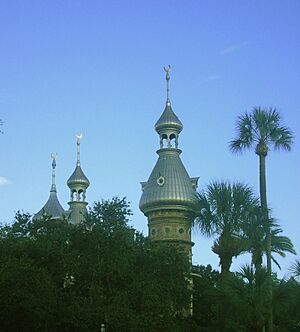
In 1891, Henry B. Plant built a very fancy hotel called the Tampa Bay Hotel. It had over 500 rooms and was a quarter-mile long. It was surrounded by beautiful gardens on the west bank of the Hillsborough River. The hotel cost $2.5 million to build, which was a huge amount of money back then.
Plant traveled around Europe while the hotel was being built. He sent back unique art from all over the world to display there. The hotel also had the first electric lights in Tampa and the first elevator in Florida.
The Tampa Bay Hotel attracted many guests for a few years. It was completely full during the Spanish–American War (see below). But after Plant died in 1899, the hotel started to decline. The city of Tampa bought the resort in 1905. It was used for community events, including the first Florida State Fair. It closed for repairs in 1930 and reopened in 1933 as the University of Tampa.
Ybor City and Cigars
The new railroad link brought another industry that would make Tampa rich. In 1885, the Tampa Board of Trade helped Vicente Martinez Ybor move his cigar factories to Tampa from Key West. Ybor liked Tampa's warm, humid climate, which kept tobacco fresh. He also liked the new transportation links. It was easy to import fine Cuban tobacco by sea, and Plant's railroad made it easy to ship finished cigars across the U.S. This connection is shown on the Seal of Tampa. It features Plant's steamship Mascotte, which brought thousands of immigrants and tons of tobacco to Tampa.
Tampa was still a small town then (population less than 5,000). So, Ybor built hundreds of small houses around his factory. These were for the thousands of Cuban and Spanish cigar workers who arrived. Other cigar makers soon moved in. Ybor City quickly made Tampa a major cigar production center. Ybor City started as a separate town. But Tampa annexed it in 1886, seeing the chance for more tax money.
Starting in the late 1880s, many Italian and some eastern European Jewish immigrants also arrived. This made Tampa one of the most diverse communities in the American South. These new arrivals found it hard to get into the cigar business. So, many opened shops and businesses that served the cigar workers. Most Italian immigrants came from two small Sicilian towns: Alessandria Della Rocca and Santo Stefano Quisquina. Tampa still has strong ties with these towns.
In 1892, Scottish businessman Hugh MacFarlane founded West Tampa. This new community across the Hillsborough River aimed to attract more cigar factories and workers. By 1900, West Tampa already had one of Florida's largest populations, mostly Cubans working in the cigar industry. West Tampa was annexed by Tampa in 1925.
The different ethnic groups in the area led to separate places during the time of segregation. This included churches, like St. James Episcopal. It was founded in 1895 for the mostly Black cigar workers from The Bahamas and Cuba. Other churches from that time include Beulah Baptist Institutional Church, started by freed slaves in 1865, and St. Paul A.M.E., founded in 1870 as Tampa's first African Methodist Episcopal church.
The Spanish–American War
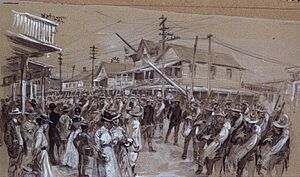
Tampa was chosen as a place for American forces to leave for Cuba during the Spanish–American War. This was mainly because of Henry Plant's connections. Lieutenant Colonel Theodore Roosevelt and his Rough Riders were among the 30,000 troops who waited in Tampa in summer 1898. This filled the town to its limits.
Those months were difficult for the troops wearing thick wool uniforms in the hot Florida weather. But they were a great help to Tampa's growing economy. It was also the only time Plant's Tampa Bay Hotel was completely full. Army officers and newspaper reporters stayed there instead of in hot, dusty tents.
The war was also very popular in Ybor City. Many Cuban cigar workers had long wanted Cuba Libre – a Cuba free from Spanish rule. Leaders like José Martí had come to Tampa many times to raise money and volunteers for their cause. With the U.S. entering the war against Spain, it seemed their dreams would soon come true.
A Crucial Time for Tampa
The building of Plant's railroad and hotels, the discovery of phosphate, and the start of the cigar industry all happened within a decade. These events were vital for Tampa's future and its survival. The town quickly grew from a struggling village to a busy small city. Except for a few temporary setbacks, this growth has continued.
Tampa in the 20th Century
In the early 1900s, cigar making was still the main part of Tampa's economy. Factories in Ybor City and West Tampa made huge numbers of cigars. In 1929, the peak year, over 500,000,000 cigars were hand-rolled in the city. As the demand for cigars dropped during the Great Depression, other industries became more important. These included shipping and, of course, tourism.
In 1904, a group of local businessmen called themselves Ye Mystic Krewe of Gasparilla. They were named after a mythical pirate, Jose Gaspar. They staged an "invasion" of the city, followed by a parade. With a few exceptions, the Gasparilla Pirate Festival has been held every year since.
Tampa has a special place in the history of aviation. This happened just ten years after the Wright brothers first flew. On January 1, 1914, Tony Jannus piloted the first flight of the St. Petersburg-Tampa Airboat Line. This was the world's first commercial passenger airline. The airline flew scheduled flights from downtown St. Petersburg, Florida, across the bay. It landed just south of where Tampa International Airport is today. It carried only the pilot and one passenger in a flying boat biplane. The Smithsonian National Air and Space Museum officially recognizes this historic flight. The pilot is honored each year with the Tony Jannus Award. An exhibit honoring the award winners is at Tampa International Airport. The airport also has a large painted mural from the 1930s. It shows "History's First Scheduled Airline Passenger Arrives in Tampa."
New Challenges and Reforms
Tampa faced problems with law and order in the mid-1900s. To protect their interests, some groups tried to influence local officials.
By the late 1940s, many of the area's groups were under the control of Santo Trafficante, Sr.. After he died in 1954, his son Santo Trafficante, Jr. took over. He made connections with groups in New York City and expanded his influence throughout Florida and into Cuba.
The time of widespread problems came to a head in the early 1950s. The Kefauver hearings, led by Senator Estes Kefauver, investigated organized crime in America. Informants came forward with surprising claims about corruption in Tampa.
Most of the accused were found not guilty or given light sentences. However, the trials helped motivate Tampa to end the problems that had lasted for decades. Rules for fairness and elections were passed. The connection between local government and organized crime weakened.
But some problems remained. In 1983, three out of five members of the Hillsborough County Commission were accused of taking bribes. Unlike earlier officials, these three were convicted and sent to federal prison. This scandal led to another round of fairness reforms.
Growth and Changes in the 20th Century
During the Great Depression, WPA projects helped build things like Peter O. Knight Airport and Drew Field. During World War II, MacDill Air Field opened for military operations.
City Expands
Before 1885, most of Tampa's small population lived within the city limits. This area was about the size of today's downtown. The city nearly doubled in size and population when it annexed Ybor City in 1886. The huge growth of the immigrant community helped Tampa's population and economy grow for decades.
In 1925, Tampa annexed West Tampa. This was another immigrant community focused on cigars, founded in 1894. This again nearly doubled the city's size and population.
Even with these additions, Tampa remained a compact city until the mid-1950s. Its northern border was the Hillsborough River, in the northern part of the Seminole Heights neighborhood.
In 1953, the city annexed over 60 square miles of undeveloped land. This included the communities of Sulphur Springs and Palma Ceia. As a result, Tampa grew very quickly, adding 150,289 residents in the 1950s. This growth also affected the city's national ranking. Tampa jumped from 85th in 1950 to 48th in 1960, its highest ranking so far. In 1961, Tampa annexed Port Tampa. This was a small community built in the 1880s by Henry Plant at the end of his railroad line.
Most of the land added to Tampa over the years was not part of any city. Five incorporated towns have been combined into Tampa: North Tampa (1885), Ybor City (1885), Fort Brooke (1907), West Tampa (1925), and Port Tampa City (1961).
University of South Florida and Theme Parks
The University of South Florida was started in 1956. This led to development in northern Tampa and nearby Temple Terrace. Busch Gardens theme park opened in 1959.
Urban Changes and Suburbs
Growth in the suburbs caused Downtown Tampa to decline as businesses moved out. Many industries began to move to outer areas. A race riot hit the city on June 11, 1967. The decline of the cigar industry and the building of Interstates 4 and 275 further damaged historic areas like Ybor City and West Tampa. During this time, the Park Tower (opened in 1973) was the city's only tall skyscraper. Programs to renew urban areas were also starting.
Population growth showed Tampa's changing fortunes. It grew very slowly in the 1960s, reaching 277,714 in 1970. However, more problems in the 1970s led to the city's first population decline in a century. It fell to 271,523 in 1980. Tampa's national ranking dropped from 50th in 1970 to 53rd in 1980. In contrast, suburban areas like Brandon and Carrollwood grew quickly.
Four attempts to combine Tampa with Hillsborough County (1967, 1970, 1971, and 1972) failed.
New Tampa Annexation
A big expansion in the city's size came with the development of New Tampa, annexed in 1988. This added a 24-square mile (mostly rural) area between I-275 and I-75. This increased the city's total land area. Despite this, the city only grew three percent in the 1980s, reaching 280,015 in 1990.
Tampa in the 21st Century
Stormy Weather
The 2004 Atlantic hurricane season was very busy for all of Florida, including Tampa. Tampa was affected by a record four hurricanes that year: Frances, Jeanne, Charley, and to a lesser extent, Ivan.
The centers of both Jeanne and Frances passed very close to Tampa. Charley was expected to hit Tampa Bay directly, which would have caused severe flooding. But the storm suddenly turned northeast. It brought only tropical storm force winds to Tampa. Ivan passed near enough to bring high seas and stormy conditions to the Tampa area.

Downtown Revitalization
Former Tampa mayor Pam Iorio made improving Tampa's downtown a priority. She focused on bringing residents into the area. Several new residential and mixed-use high-rises were planned and built. Another of Mayor Iorio's projects was the Tampa Riverwalk. This plan expanded the use of land along the Hillsborough River in downtown, where Tampa first began. Several museums are part of the plan, including the Tampa Bay History Center, the Tampa Children's Museum, the Tampa Museum of Art, and the Florida Museum of Photographic Arts. Tampa Mayor Bob Buckhorn has continued this development work.
Images for kids


